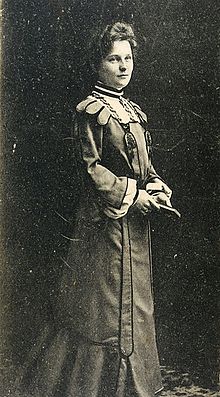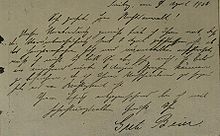Grete Beier
Marie Margarethe Beier , called Grete Beier , (born September 15, 1885 in Erbisdorf , † July 23, 1908 in Freiberg ) was the last woman to be publicly executed in the Kingdom of Saxony .
Life
Grete Beier was the daughter of Brander mayor Ernst Theodor Beier and his wife Ida Karoline, born Clausnitzer.
In 1905 she got to know the clerk Johannes Heinrich Merker and secretly got engaged to him without her parents' knowledge. After breaking off her relationship with him because of his infidelity, she met the chief engineer Heinrich Moritz Curt Preßler in 1906 and became engaged to him at the request of her parents.
Grete's relationship with Pressler was always cool, and because of his imperious nature there soon came an argument between the two. Thereupon she secretly got in touch with Merker, who was meanwhile being investigated for embezzlement . From this intercourse she became pregnant and had the child aborted in November 1906.
Her official fiancé Preßler planned the wedding for May 14, 1907. Grete tried to prevent this and at the same time raised Merker's hopes by passing him forged love letters from a non-existent Italian named Ferroni to Pressler.
After a relative, the manager of the poor house in Freiberg, Kröner, died in April 1907, she forged his will , stole money from a cassette kept in her parents' house and withdrew his savings, sharing the money with Merker.
At the same time, a reader's request to draft a will for the establishment of the bride as sole heir was answered and printed in a Freiberg newspaper.
A few days later, Grete Beier drew up a forged will for her groom and poisoned him with potassium cyanide the day before the planned wedding in Chemnitz , and then shot him in the mouth with a revolver to simulate his suicide . Immediately after the crime, she sent Ms. Ferroni further letters to make the suicide credible.
In May 1907 the theft from the cassette was discovered. In the course of the investigation, she tried further falsifications and lies to cast suspicion on others. After her arrest in June 1907, an illegal abortion trial was also initiated. A little later, her lover, Merker, was also arrested. In November she then confessed to the murder of Pressler.
After a pardon from King Friedrich August III. had been rejected, Grete Beier on 23 July 1908 aged 22 years was by the state executioner Moritz fire on the scaffold in the yard of the District Court at Albert Park in Freiberg guillotined . She was buried in the family grave at the Johannisfriedhof in Dresden.
effect
This case caused quite a stir, in part also to public outrage over the execution of the judgment. For years afterwards, various press products referred to the execution of Grete Beier. Under the pseudonym Ignaz Wrobel, Kurt Tucholsky glossed the case in the Schaubühne in 1913:
“As far as the milieu is concerned, read Grete Beier: it was not the murder at the end that created this atmosphere of dullness, bad air and greasy dishes. “While he was having coffee, he began to say what a shame it was that the wedding still couldn't take place. He couldn't wait forever to get married. Now he was beginning to be tender. He offered her cognac, she thanked you, she didn't drink any. So she should at least pour him a glass. With that he went out to the toilet. "Love her, love her! That's how it's done, and unless a court hearing or a wrongly addressed letter lifts a corner from the curtain - we don't know. "
In 1912 Tucholsky wrote in the social democratic Vorwärts about the execution of a convicted robbery murderer:
“(...) a door opens and they drag someone out who is supposed to die and doesn't want to. (...) The public prosecutor, an official down to the tips of his mustache, reads something to the semi-madman, fearful of vertebrates, "... he has not exercised his right to pardon" ... he is bellowed, screeched over by the madman who torments himself and writhes under him Fists of the executioners. (…) In total there were only 60 (sixty) spectators this time. At Grete Beier's home there was a small folk festival: at that time 200 adorned the courtyard.
literature
Scientific contributions
- Gotthold Leistner: Saxony and the guillotine. A contribution to the story of a killing monster . In: Sächsische Heimatblätter , Volume 48 (2002) pp. 130–149.
Contemporary representations
- Jury trial against the mayor's daughter Grete Beier from Brand near Freiberg before the Königl. Freiberg jury charged with the deceitful murder of her groom, the engineer Pressler . Hager, Chemnitz 1908 ( digitized version )
Literary adaptations
- Günter Spranger : The game of lies . The criminal case of Grete Beier . Greifenverlag, Rudolstadt 1980
- Katrin Lange : Me, Grete Beier, murderer . (Play), world premiere: August 22, 2008 Central Saxon Theater Freiberg and Döbeln
- The Grete Beier case is mentioned in Guntram Vesper's novel Frohburg ( Prize of the Leipzig Book Fair 2015).
- Kathrin Hanke, The poisoner Grete Beier , Gmeiner Verlag, Meßkirch 2017
Media edits
- As early as 1908, the story of Grete Beier was filmed by Gustav Schönwald under the title Im Irrwege der Liebe .
- The Mitteldeutsche Rundfunk dealt with the case on January 7, 2008 in the television documentary series " The Trace of the Ancestors ".
Web links
- Various documents, sources on Grete Beier ( Memento from October 9, 2007 in the Internet Archive )
- Literature by and about Grete Beier in the catalog of the German National Library
- Literature by and about Grete Beier in the Saxon Bibliography
Individual evidence
- ^ Gerhard Lamprecht : German Silent Films 1903-1912 . Deutsche Kinemathek eV, Berlin 1969, p. 34 .
| personal data | |
|---|---|
| SURNAME | Beier, Grete |
| ALTERNATIVE NAMES | Beier, Marie Margarethe (full name) |
| BRIEF DESCRIPTION | German murderess |
| DATE OF BIRTH | September 15, 1885 |
| PLACE OF BIRTH | Erbisdorf , Kingdom of Saxony , German Empire |
| DATE OF DEATH | July 23, 1908 |
| Place of death | Freiberg , Kingdom of Saxony , German Empire |



